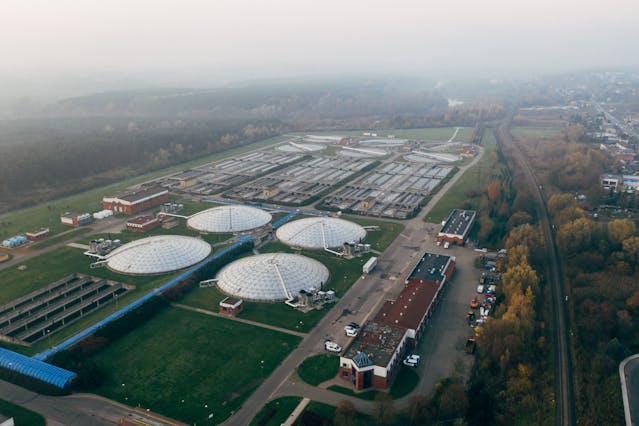
- admin
- July 23, 2024
Selecting the Right Material for Wastewater Plant Tanks
Selecting the right material for wastewater plant tanks is essential for efficient, long-lasting, and safe treatment. Since wastewater treatment involves various chemicals and potentially corrosive substances, picking the right material is crucial. In this blog post, we will look at the key factors and options for choosing the best material for wastewater plant tanks.
Key Considerations for Material Selection
When you choose materials for wastewater plant tanks, you need to consider several factors to ensure the tanks work well in their specific conditions. These factors include:
1. Chemical Resistance
Wastewater often has many chemicals that can be corrosive. The tank material must resist these chemicals to avoid damage and last longer. Always consider the specific chemicals in the wastewater when choosing the tank material.
2.Structural Integrity
Wastewater often has many chemicals that can be corrosive. The tank material must resist these chemicals to avoid damage and last longer. Always consider the specific chemicals in the wastewater when choosing the tank material.
3. Temperature Tolerance
Wastewater temperatures can change a lot, especially in industrial settings. Another key point, the material you choose must handle these temperature changes without losing its strength or chemical resistance.
4. Ease of Maintenance
Generally ,choosing materials that are easy to clean and maintain to cut down on downtime and reduce costs. Furthermore, Make sure the tanks are simple to inspect, clean, and repair.
5. Environmental Impact
Unquestionably ,Opt for sustainable materials that have a minimal environmental impact throughout their lifecycle. On the positive side, Eco-friendly materials help meet regulatory requirements and support corporate sustainability goals.
Common Materials Used in Wastewater Plant Tanks
Several materials are commonly used for wastewater plant tanks, each with its advantages and disadvantages. Below, we explore some of the most popular options:
1. Concrete
Concrete is a traditional material used for wastewater tanks due to its strength and durability. Additionally, It is highly resistant to environmental stresses. Therefore, can be designed to handle large capacities.
Advantages:
- High strength and durability
- Resistant to environmental stresses
- Long lifespan
Disadvantages:
- Susceptible to chemical attack if not properly coated or treated
- Heavy and requires significant structural support
- Potential for cracking over time
2. Fiberglass Reinforced Plastic (FRP)
FRP tanks are made from a combination of fiberglass and resin, providing excellent chemical resistance and flexibility.
Advantages:
- High chemical resistance
- Lightweight and easy to install
- Low maintenance requirements
Disadvantages:
- Can be more expensive than other materials
- Susceptible to UV degradation if not properly protected
- Limited impact resistance compared to steel
3. High-Density Polyethylene (HDPE)
HDPE is a popular choice for wastewater tanks due to its chemical resistance and flexibility.
Advantages:
- Excellent chemical resistance
- Lightweight and easy to handle
- Cost-effective
Disadvantages:
- Can be susceptible to damage from UV exposure
- Limited structural strength compared to concrete and steel
- Can deform under high temperatures
4. Stainless Steel
Stainless steel tanks are known for their strength, durability, and resistance to corrosion.
Advantages:
- High strength and durability
- Excellent corrosion resistance
- Long lifespan
Disadvantages:
- Higher cost compared to other materials
- Can be susceptible to certain types of chemical attack (e.g., chloride-induced corrosion)
- Requires careful handling during installation to prevent damage
5. Carbon Steel with Protective Coatings
Carbon steel tanks are often used in wastewater plants, with protective coatings applied to enhance their chemical resistance.
Advantages:
- High strength and durability
- Cost-effective compared to stainless steel
- Versatile and customizable
Disadvantages:
- Requires regular maintenance to ensure protective coatings remain intact
- Susceptible to corrosion if coatings are damaged
- Heavier than materials like HDPE and FRP
Making the Right Choice
Choosing the right material for wastewater plant tanks requires balancing the key factors mentioned earlier. You should carefully assess the specific conditions and needs of your wastewater treatment process. Talking to industry experts and material specialists can also give you valuable insights and help you make the best decision.
Conclusion
Hence, choosing the right material for wastewater plant tanks is crucial for efficient, safe, and long-lasting operations. Additionally , plant operators should consider factors like chemical resistance, strength, temperature tolerance, maintenance ease, and environmental impact to pick the best material for their needs. Whether they choose concrete, FRP, HDPE, stainless steel, or carbon steel with coatings, making the right choice will greatly improve the success of the wastewater treatment process.
For more details on selecting the right material for your wastewater plant tanks and to explore our quality storage solutions, visit GSC Tanks.
- Right Material for Wastewater Plant Tanks
Category
- Above Ground Fuel Tanks
- Above Ground Gas Storage Tank
- Above Ground Storage Tanks
- Above Ground Water Storage Tanks
- Agricultural Tanks
- Chemical storage Tanks
- Diesel Fuel Storage Tanks
- Diesel Storage Tanks
- Exernal FloatingRoof Tanks
- Farm Water Tank
- Fiberglass Oil Tanks
- Fiberglass Septic Tanks
- Fiberglass Tanks
- Fiberglass Underground Fuel Storage Tanks
- Field Erected Tanks
- Floating Roof Tank
- Food and Beverage Tanks
- Fuel tank
- Industrial Chemical Storage Tanks
- Industrial Gas Tanks
- Industrial Plastic Tanks
- Industrial Storage Tanks
- Industrial Tank heating pads
- industrial tanks
- Natural gas
- Natural gas vs Propane
- oil storage tank
- Oil Storage Tanks
- Peracitic Acid
- Petroleum Tanks
- Residential gasoline storage tanks
- Residential Water Storage Tanks
- Sodium Hydroxide Storage Requirements
- Sodium Hypochlorite Storage Tanks
- Steel Storage Tanks
- storage tank failure prevention
- Storage Tanks
- Sulfuric Acid Tanks
- Uncategorized
- UnderGround Storage Tanks
- Waste water tank
- Water Storage Tanks

 Tank Size Calculator
Tank Size Calculator






